


1.A festival of showy female riders
2.The aesthetics of Japanese horses performing Japanese traditions
3.Sakura Yabusame Photo Contest
4.Recipient of the 20th Furusato Event Grand Prize
5.Recipient of COOL JAPAN AWARD 2019
第23回桜流鏑馬 (Sakura Yabusame 2026)
Women’s yabusame horseback archery competition under the cherry blossom trees!
■Date: April 18-19, 2026
■Time: 10:00-14:00
■Location: Towada City Central Park (Chuo Koen) Yabusame Venue
■Admission: Free
■Events/Attractions:
Women’s Yabusame competition
Horse Riding Experience (500yen~)
Yabusame Event Venue Limited Edition Goods Sales
& More!
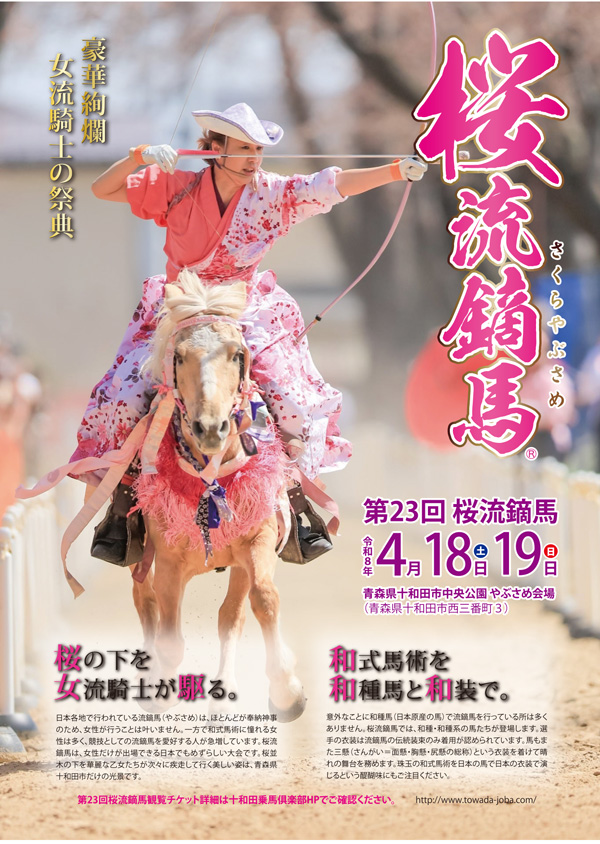
Sakura Yabusame is the combination of traditional Japanese houseback archery with beautiful rows of cherry blossom trees in Towada City. Towada was previously home to Japan’s largest horse Calvary which made the city a bustling place. The sakura trees planted at the time still remain.
Towada Horseback Riding Club is the perfect place for people to interact with horses. The rituals that were held through this equine(horse) culture was historically only performed by men. However, it has now become a competitive sport for both men and women to enjoy.
The appeal of Sakura Yabusame
In horseback riding, three types of gait are used: walking pace (namiashi), trot (hayaashi), and canter (kakeashi). The canter is the fastest of these.
In yabusame, however, an even faster gait called canter and gallop (shuho) is used. In horse racing, this is a gallop. Just seeing the horses running at top speed is quite a sight, but this becomes all the more impressive as the riders shoot arrows through a target. As an ancient Japanese martial art, yabusame also involves strict etiquette in its rituals and actions. The attire of the horses and the riders are dignified and quaintly old-fashioned.
Yabusame, once held at festivals and as an event around Japan, is not readily seen today. At the Towada Horseback Riding Club, volunteers who appreciate Japanese-style riding encourage competitive yabusame as a way to preserve and use Japanese breeds of horse while promoting sports.

All eyes on the splendid garb
The garments worn by participants in Sakura Yabusame are made by Towada Horseback Riding Club. Featuring individuality and splendor based on participants’ individual requests, the garments are designed with functionality and with consideration of women as wearers, while retaining Japanese elements.

Taking three shots in one run
Along a track about 100 meters in length are three mounted archery targets at different locations, each awarding a different point value. The horse runs the course in about 10 to 13 seconds, so there’s not a moment to be missed.
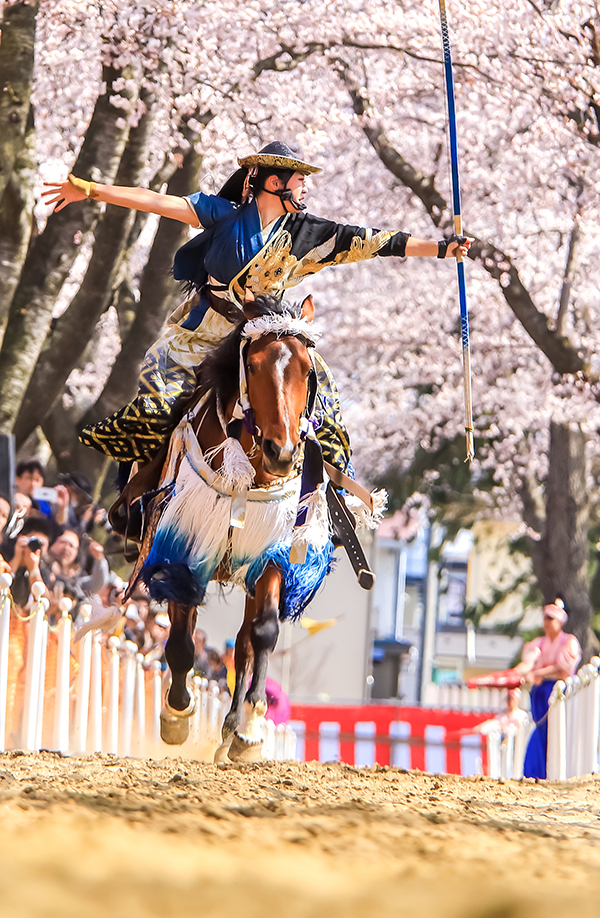
Points and time: The line between victory and defeat
Targets can be easy to hit but low-scoring, or difficult to hit but high-scoring. A key point in competing is running fast while staying within the rules. Tactics among the riders are also important.
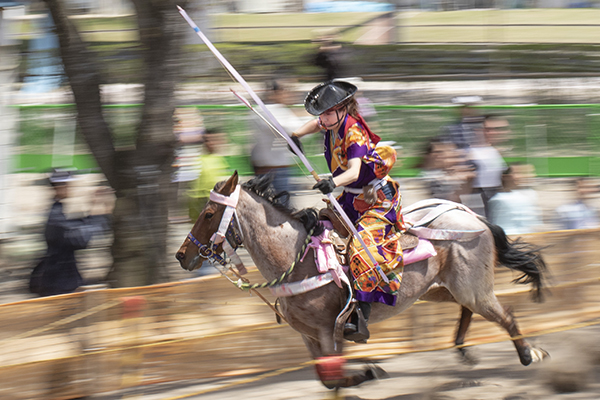
Refined Japanese horsemanship on Japanese horses
Surprisingly few locations practice yabusame using horse breeds native to Japan. Sakura Yabusame features horses made to resemble the Nanbugoma horses that once roamed the area. Spectators can enjoy the genuine thrill of refined Japanese horsemanship performed on Japanese horses.
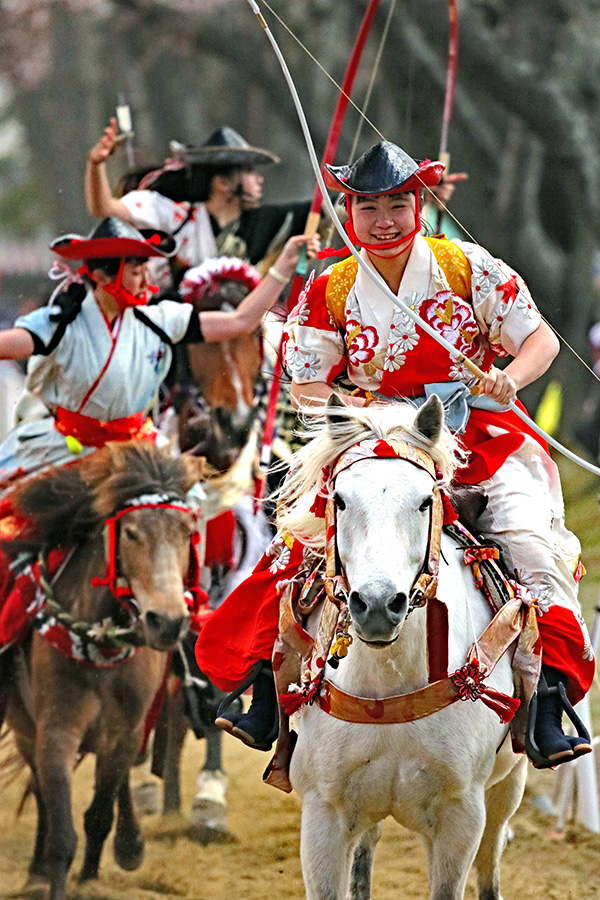
Highlights of Sakura Yabusame
Surprisingly, there are few locations that practice yabusame using horse breeds native to Japan. Sakura Yabusame features horses made to resemble the Nanbugoma horses that once roamed the area. Spectators can enjoy the genuine thrill of refined Japanese horsemanship performed on Japanese horses.
Traditional garb is part of the rules
Only traditional yabusame garments may be worn. Horses also wear gear known as sangai, the collective term for the bridle, martingale, and crupper. This makes for a gala occasion!
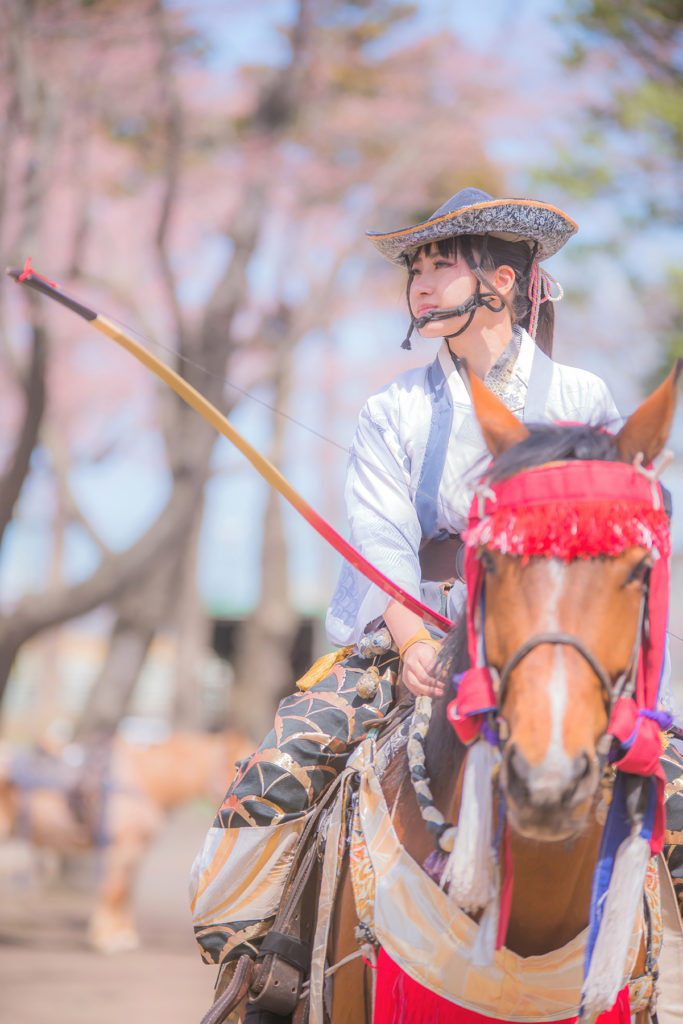
The speed of the horse is a tactic
Higher score is awarded to (1) the rider with the most hits, or (2) if riders have an equal number of hits, the rider who rode fastest within the specified time. Running the horse fast makes targets harder to hit; riding more slowly may result in missing the time limit.
Tension spanning two days
Awards are given on the first and the second days, with riders’ ranking decided from overall results for the two days.
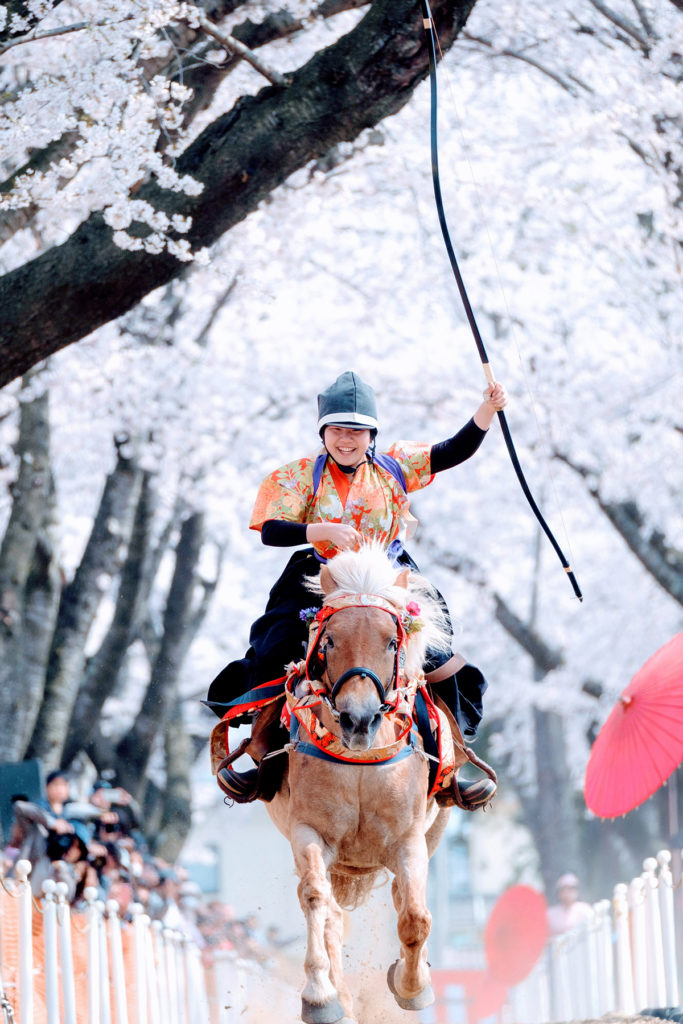
Taking three shots in one run
Each rider runs the track two to four times, and shoots at each of three targets set up along the track.
The pitfall of forfeiture
Falling off the horse or exceeding the time limit result in forfeiture. Riders must run the distance of about 100 meters from the first to the third target within 17 seconds at the beginner level, 14 seconds at the intermediate level, and 12 seconds at the pro level. There is no leeway for walking the horse and aiming carefully.

The horse is of course a Japanese horse
Horses are generally Japanese breeds or descended from these, with about 40 horses gathered at the venue. Japanese equestrianism on Japanese horses… This seems it would be a given, but is actually a very rare sight today, when Japanese breeds are on the decline.
A specialty of Towada: “Ringside seats”
There are few venues with such a close distance between the spectators’ seats and the horses. Horses run past the spectators, kicking up sand as they go. Fully experience this power at Towada, live and up close.

Ultimate horseback technique
Releasing both hands, the rider urges the horse forward, and fires an arrow from the bouncing horseback position. The feat demonstrates advanced techniques that differ from those of horse racing and equestrian competitions.
Archery compressed into five seconds
The time between targets is about five seconds. During this time, the rider knocks an arrow, takes aim at the target, draws the bow, and shoots the arrow. Victory or loss can turn on an instantaneous error. This is a moment of held breath and sweaty palms.

The bodily dynamics of canter and gallop
Horses run in what is called shuho, or gallop. In this mode of running, the horse’s shaking lessens as speed increases. This is also exhilarating run for the rider, who “becomes the wind.”
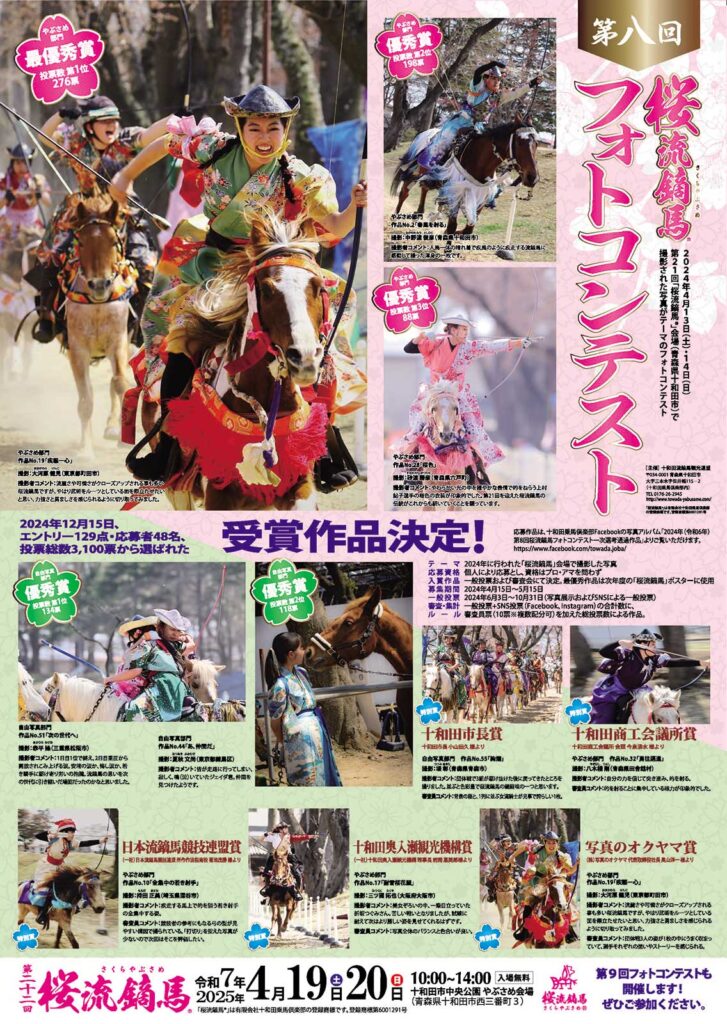
Yabusame, with its decisive moments occurring within a sprint of just 10 seconds or so, is a very popular event for camera enthusiasts.
To communicate Sakura Yabusame to many people, we hold a photo contest showcasing photographs by fans who appreciate the splendor.
Submitted photos that pass secondary selection appear in traveling exhibits. The photos are narrowed down through final judging; winning photos receive awards decided by experts and appear in announcement posters for the next year’s event.
The winning organizations in the 20th Furusato Event Grand Prize held by the Japan Center for Regional Development were announced on March 2, 2016. The highest prize, the Prime Minister’s Award, went to Sakura Yabusame.
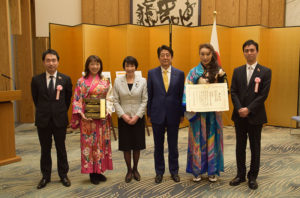
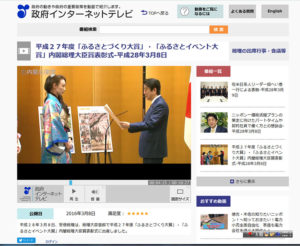
Furusato Event Grand Prize, Government Internet TV (video)
3/8 Award Ceremony Photo Album (Prime Minister’s Office)
“3/2 Award Ceremony (Tokyo International Forum)
3/2 Award Ceremony Photo Album
About the Furusato Event Grand Prize
The Furusato Event Grand Prize was established to recognize the many events that create vitality in regional areas and to introduce them to the country as a whole, supporting further development of such furusato (hometown) events. By encouraging the creation and development of such events, it aims to protect the customs, traditions, and lifestyles unique to regions, foster regional attachment and pride, and spur revitalization that leads to interactions inside and outside the regions.
Of 130 events submitted from around the country, 7 received awards.

Sponsored by the Kyoto-based Cool Japan Association with backing by the Ministry of Economy, Trade and Industry, Ministry of Foreign Affairs, Ministry of Environment, Japan Tourism Agency, Cabinet Office, Kyoto Prefecture, Kyoto City, and Japan National Tourism Organization with JETRO as Official Outbound Partner, the COOL JAPAN AWARD 2019 was awarded to Sakura Yabusame on May 27, 2019.

This award is conferred every two years under a program established by the Cool Japan Association in 2015 to evaluate uniquely Japanese products, culture, and more from an international perspective.

■Reasons for selection
Representative comment from a foreign judge
“It’s cool to see sakura, horses, tradition, and skill all come together as practitioners in traditional garb ride among the falling cherry blossoms and shoot arrows. One can feel how both women and the young generation are inheriting cherry blossoms and traditions.”
* Excerpt from the Cool Japan Awards introduction page
Copyright © 十和田流鏑馬公式総合案内 All rights reserved.